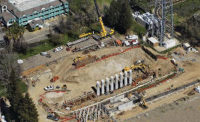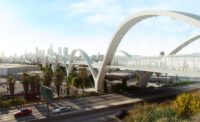Revenue from design work continues its modest upswing, according to an annual survey of top design firms conducted by ENR California and McGraw Hill Construction. The 109 participating firms collectively produced $3.66 billion of design work on projects located in California during 2013, an increase of 5% over the previous year. But design firms will face an increasing level of difficulty in finding the staff needed to meet the demands of California's infrastructure and water needs, say respondents.
"The state's aging infrastructure, current drought conditions and the ripple effects on energy supply and demand all present opportunities for our industry and government to come together to solve these significant challenges," says Jim Zaniboni, excecutive vice president and California district general manager with AECOM in San Francisco.
Staffing Wars
Design firms are augmenting staff levels to meet the increased work load. Firms participating in the survey reported a total of 5,098 licensed architects and engineers on their payrolls, an increase of nearly 3% from the previous year's survey.
New York City-based Arup, ranked seventh in revenue among design firms working in California, forecasts double-digit growth in both revenue and staffing. "We will continue to recruit a significant number of new graduates, aligned with our long-term goals and practices, and we are continually seeking more diverse graduate intake," says Andy Howard, Arup Americas COO. "But there is a war for talent, diversity and language skills for seasoned and experienced project-delivery people."
Charlie Downs, senior principal with Sacramento-based Architectural Nexus, says recruitment is "the single biggest challenge facing our firm as the economy improves. There has been a significant readjustment of human resources in the design industry in which many affected staff have moved out of the area or have left the profession entirely, as we've seen with CAD staff." Discouraging job prospects during the recession reduced the number of young people entering the design fields, which is now exacerbating current shortages, he adds.
Tight profit margins dictate the need for designers to wear many hats and use technology to maximize productivity. "Fees today will not support two staff members, such as an experienced practitioner sketching by hand and a recent graduate who has a high level of skill with technology but doesn't know what to model," says J. Peter Devereaux, president of Harley Ellis Devereaux in Los Angeles. "Fees demand that we find one person who can combine those skills to deliver what is required."
While the major urban centers enjoy an ongoing growth cycle, large-scale rural projects such as high-speed rail and natural resource extraction are spurring some firms to open branches in the interior of California. Revenue generated from the petroleum sector jumped 42% during 2013, for example. However, if and when the high-speed rail project is completed, the region may not produce sufficient new project opportunities to support all of these new firms, says Michael D. Knopf, president of Roseville-based Quad Knopf.
























Post a comment to this article
Report Abusive Comment